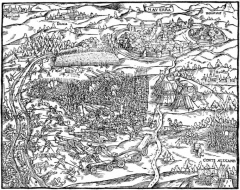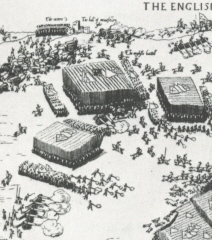Tactics
16th Century field tactics were undergoing a Renaissance as much as any other science. Warfare of the 15th Century late medieval battles had slowly adapted as the power of the artillery and small arms came to the fore. By the time of Flodden the day of the longbow and stagnant plodding melees of heavily armoured footmen was drawing to a close on mainland Britain. Flodden was to be the last 'bill / bow battle' where the power of the English longbowmen and the merciless hacking of their billmen proved decisive. Pinkie was fought by the English with more dynamism, a greater variety of unit types and at distances determined by the range of cannons.
The Scottish army came down Branxton Hill in 1513 in 'the manner of the Almeins'. 5 massive wards of men 2- 4,000 men stepped off in echelon towards the gathering English. Their intention was to hit home hard and fast as the English deployed, smashing through their shallower formations and pushing them back towards the Palinsburn. However such tactics depend on momentum and coordination. Both these factors were lost in the small burn at the foot of Branxton Hill. The Scots were butchered and their lairds cut down.
 But such tactics were not peculiar to the Scots or an aberration by their leaders. The use of pike blocks advancing in such large numbers had paid great dividends across battlefields all across Europe. In particular Swiss and German Landsknechts divisions were proving indispensable in the fighting on the mainland.
But such tactics were not peculiar to the Scots or an aberration by their leaders. The use of pike blocks advancing in such large numbers had paid great dividends across battlefields all across Europe. In particular Swiss and German Landsknechts divisions were proving indispensable in the fighting on the mainland.
So where did the Scots go so tragically wrong? On paper they had the ideal troops for such tactics - Scots brought up on the use of spears since the days of Wallace or be they somewhat shorter than the pike. But schiltrons tended to be stationary defensive bodies. Pike blocks needed to move and fast (Ironically the schiltrons at Bannockburn substantiate this point as they proved victorious in attack against the English wards on the second day. Those stationery schiltrons at Falkirk and Homildon Hill prove the frailties of the defensive option). Moving such large bodies of men required excellent command and control. The wards at Flodden had precious little of either. True James had hired in help in the form of French sergeants who gamely set about training the troops in the little time they had on campaign. But without the years of practice ingrained into them, like the Swiss, there was little chance of the training being effective in such a short time. Likewise the Swiss command and control was consistent from the front of the pike block to the rear. The Scots at Flodden chose to put their lairds and leaders in the front ranks, providing a strong outer layer but leaving a soft under belly of poorly motivated and poorly armoured troops to man the back ranks. Once the king and his supporters had been killed off the remaining Scots were left leaderless and being trapped by the terrain, became easy victims to the English billmen.
If James had had the benefit of hindsight he may have noticed that the Swiss and Germans did not depend on weight of pikemen alone. In front, on the flanks and within their ranks were scores of skirmishes armed with crossbow and latterly harquesbus. These troops were their to protect the pikemen from the enemy's missile men. The Scots had very few such men at Flodden leaving the English bowmen free to rain down shafts upon the packed ranks. Fortunately for the Scots lairds they had little effect due to the wetness of the bowstrings and the defensive qualities of the Scottish armour. However they would have certainly disrupted the Scottish rear ranks as they advanced.
 In 1547 at Pinkie, little had appeared to have changed. Certainly Arran led his men forward with the intention of launching his pike against an unformed enemy. But again his wards lacked suitable support, either from bow or shot. And again the English first held up the pike by cavalry charges and then destroyed them, not by handblows this time, but by artillery and harquesbus.
In 1547 at Pinkie, little had appeared to have changed. Certainly Arran led his men forward with the intention of launching his pike against an unformed enemy. But again his wards lacked suitable support, either from bow or shot. And again the English first held up the pike by cavalry charges and then destroyed them, not by handblows this time, but by artillery and harquesbus.
So what of the tactics at Linlithgow? Can we assume the wards described in the accounts were primarily pike armed designed to attack rather than defend.? Well to a point yes. However pike were expensive weapons to have around the house. Most were kept in armouries around the country then taken to the muster for distribution to the levy. Most men appeared on the 'sounding of the common bell' with those weapons they had around the house. Bills, harlberds, jedwart staves and half pike were more likely to be used by the levy. Certainly Angus and to a lesser extent Arran and Lennox would have had little time to distribute and more importantly train great bands of pike. Therefore it is likely the wards at Linlithgow were primarily pole armed with a hardcore of professional retinue pike manning their front ranks.
Skirmishes to would have been available. The muster demanded a certain proportion of troops to be bow or harquesbus armed. But again with little time for training, the coordination required between skirmishes and pike block would have been sadly lacking and the firepower they could deliver somewhat lack lustre.
Artillery was the new boy on the block. Certainly the guns added two new dimensions to the 16th Century battlefield - those of smoke and noise. The Flodden artillery had proven to be sadly inadequate under field conditions; poorly served and badly positioned meant they were outgunned lighter more professional opposition. Big guns become a burden on a mobile battlefield often being confined to prepared positions with little chance of effective redeployment. Lighter guns lacked range and firepower but at least could be moved closer to the action and could be redeployed as required. The guns at Linlithgow may have been both types. Arran had time to prepare heavier guns to guard the approach to the bridge the night before. His lighter guns and those of Lennox were available for redeployment as the Lennox battles swung around the flank and the Hamilton troops changed face to meet them. The noise and smoke impeded the command and control required to carry out co-ordinated attacks.

